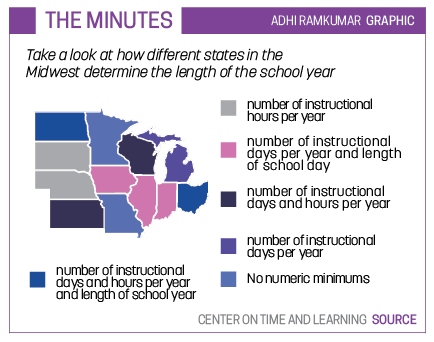 To make up for two snow days, Carmel Clay Schools (CCS) added 10 minutes to every school day. State legislature requires Indiana schools to have 180 days of instructional time (defined as time in which students participate in an approved educationally-related activity under the direction of a teacher) each school year. However, CCS has performed well enough to bypass the day requirement, so our district is able to meet a requirement of 64,800 minutes instead. While the addition of time does pose a solution to the issues the district faces, it also creates an inconvenience without providing much instructional benefit.
To make up for two snow days, Carmel Clay Schools (CCS) added 10 minutes to every school day. State legislature requires Indiana schools to have 180 days of instructional time (defined as time in which students participate in an approved educationally-related activity under the direction of a teacher) each school year. However, CCS has performed well enough to bypass the day requirement, so our district is able to meet a requirement of 64,800 minutes instead. While the addition of time does pose a solution to the issues the district faces, it also creates an inconvenience without providing much instructional benefit.
To be fair, adding ten minutes per day rather than two non-school days to make up the time does fit the state’s requirements without much disruption. The HiLite staff commends administration for taking decisive action and working within their limitations to come up with a viable solution.
However, the additional time does not have a significant impact on class time. Each class is only extended by two and one-half minutes on average, which is not enough time to affect lessons or students’ learning.
Not only that, but the extension of time also leads to problems for students with extracurriculars and after-school activities. Clubs and sports teams have had to change their schedules and accommodate the new late bus times, something not made clear to students and staff. The later release is also an issue for those with commitments outside of school, as students now have less time to get there.
One factor the district considered when making the change was graduation, which is scheduled for the  last day of school. We understand that scheduling graduation around other schools’ schedules can be difficult, but in future years, the district should consider planning the graduation ceremony a few days after the last day of school for such an occurrence. The district should also consider building more flex days into the schedule to accommodate possible closings. While not much can be done this year, CCS should consider anticipating different circumstances in future years. By doing so, the district can prevent the problems the community currently faces, as well as their own.
last day of school. We understand that scheduling graduation around other schools’ schedules can be difficult, but in future years, the district should consider planning the graduation ceremony a few days after the last day of school for such an occurrence. The district should also consider building more flex days into the schedule to accommodate possible closings. While not much can be done this year, CCS should consider anticipating different circumstances in future years. By doing so, the district can prevent the problems the community currently faces, as well as their own.




























![Keep the New Gloves: Fighter Safety Is Non-Negotiable [opinion]](https://hilite.org/wp-content/uploads/2024/12/ufcglovescolumncover-1200x471.png)
















































![Review: “We Live in Time” leaves you wanting more [MUSE]](https://hilite.org/wp-content/uploads/2024/12/IMG_6358.jpg)
![Review: The premise of "Culinary Class Wars" is refreshingly unique and deserving of more attention [MUSE]](https://hilite.org/wp-content/uploads/2024/12/MUSE-class-wars-cover-2.png)
![Introducing: "The Muses Who Stole Christmas," a collection of reviews for you to follow through winter [MUSE]](https://hilite.org/wp-content/uploads/2024/12/winter-muse-4.gif)
![Review: "Meet Me Next Christmas" is a cheesy and predictable watch, but it was worth every minute [MUSE]](https://hilite.org/wp-content/uploads/2024/11/AAAAQVfRG2gwEuLhXTGm3856HuX2MTNs31Ok7fGgIVCoZbyeugVs1F4DZs-DgP0XadTDrnXHlbQo4DerjRXand9H1JKPM06cENmLl2RsINud2DMqIHzpXFS2n4zOkL3dr5m5i0nIVb3Cu3ataT_W2zGeDAJNd_E-1200x884.jpg)
![Review: "Gilmore Girls", the perfect fall show [MUSE]](https://hilite.org/wp-content/uploads/2024/11/gilmore-girls.png)
![Review in Print: Maripaz Villar brings a delightfully unique style to the world of WEBTOON [MUSE]](https://hilite.org/wp-content/uploads/2023/12/maripazcover-1200x960.jpg)
![Review: “The Sword of Kaigen” is a masterpiece [MUSE]](https://hilite.org/wp-content/uploads/2023/11/Screenshot-2023-11-26-201051.png)
![Review: Gateron Oil Kings, great linear switches, okay price [MUSE]](https://hilite.org/wp-content/uploads/2023/11/Screenshot-2023-11-26-200553.png)
![Review: “A Haunting in Venice” is a significant improvement from other Agatha Christie adaptations [MUSE]](https://hilite.org/wp-content/uploads/2023/11/e7ee2938a6d422669771bce6d8088521.jpg)
![Review: A Thanksgiving story from elementary school, still just as interesting [MUSE]](https://hilite.org/wp-content/uploads/2023/11/Screenshot-2023-11-26-195514-987x1200.png)
![Review: "When I Fly Towards You", cute, uplifting youth drama [MUSE]](https://hilite.org/wp-content/uploads/2023/09/When-I-Fly-Towards-You-Chinese-drama.png)
![Postcards from Muse: Hawaii Travel Diary [MUSE]](https://hilite.org/wp-content/uploads/2023/09/My-project-1-1200x1200.jpg)
![Review: "Ladybug & Cat Noir: The Movie," departure from original show [MUSE]](https://hilite.org/wp-content/uploads/2023/09/Ladybug__Cat_Noir_-_The_Movie_poster.jpg)
![Review in Print: "Hidden Love" is the cute, uplifting drama everyone needs [MUSE]](https://hilite.org/wp-content/uploads/2023/09/hiddenlovecover-e1693597208225-1030x1200.png)
![Review in Print: "Heartstopper" is the heartwarming queer romance we all need [MUSE]](https://hilite.org/wp-content/uploads/2023/08/museheartstoppercover-1200x654.png)



